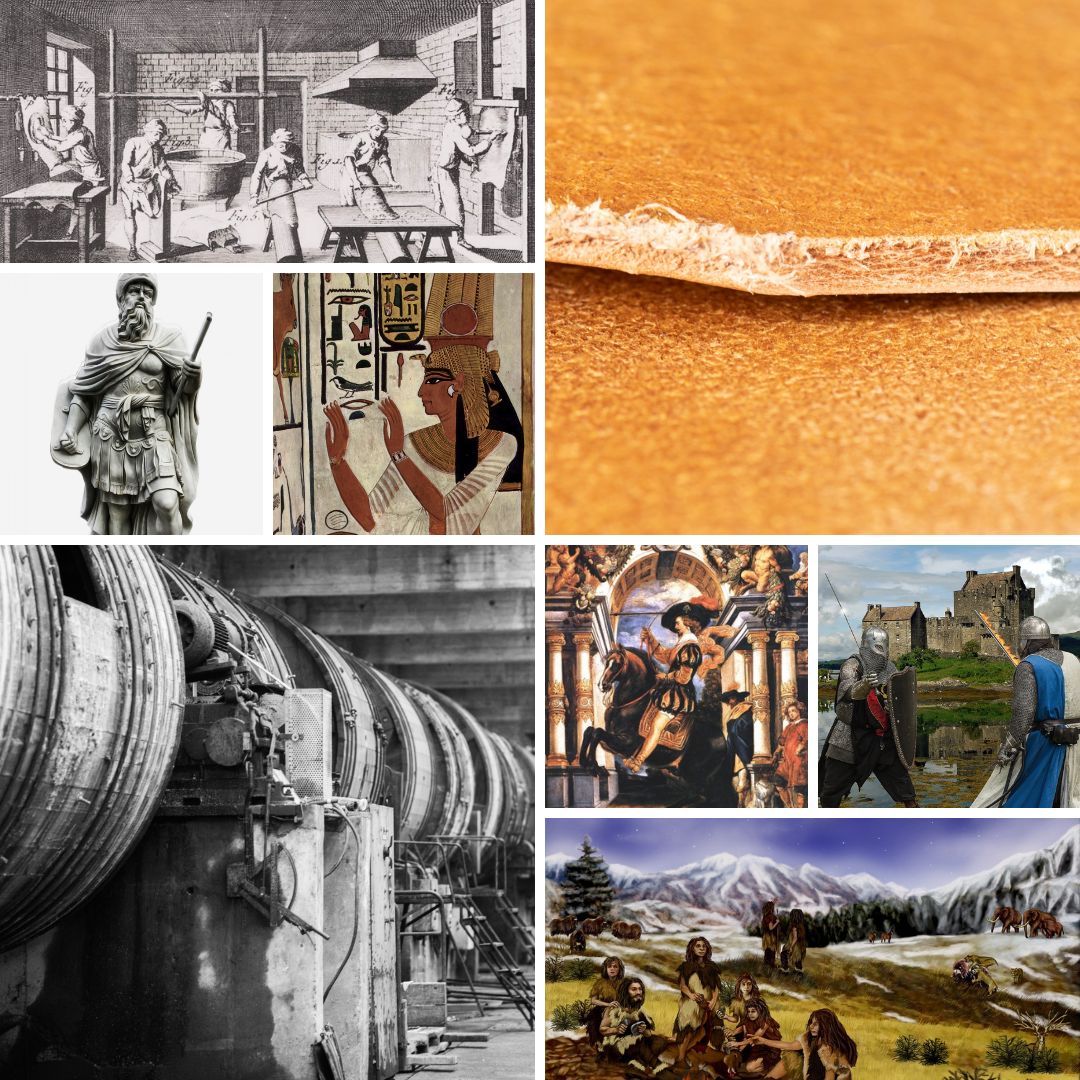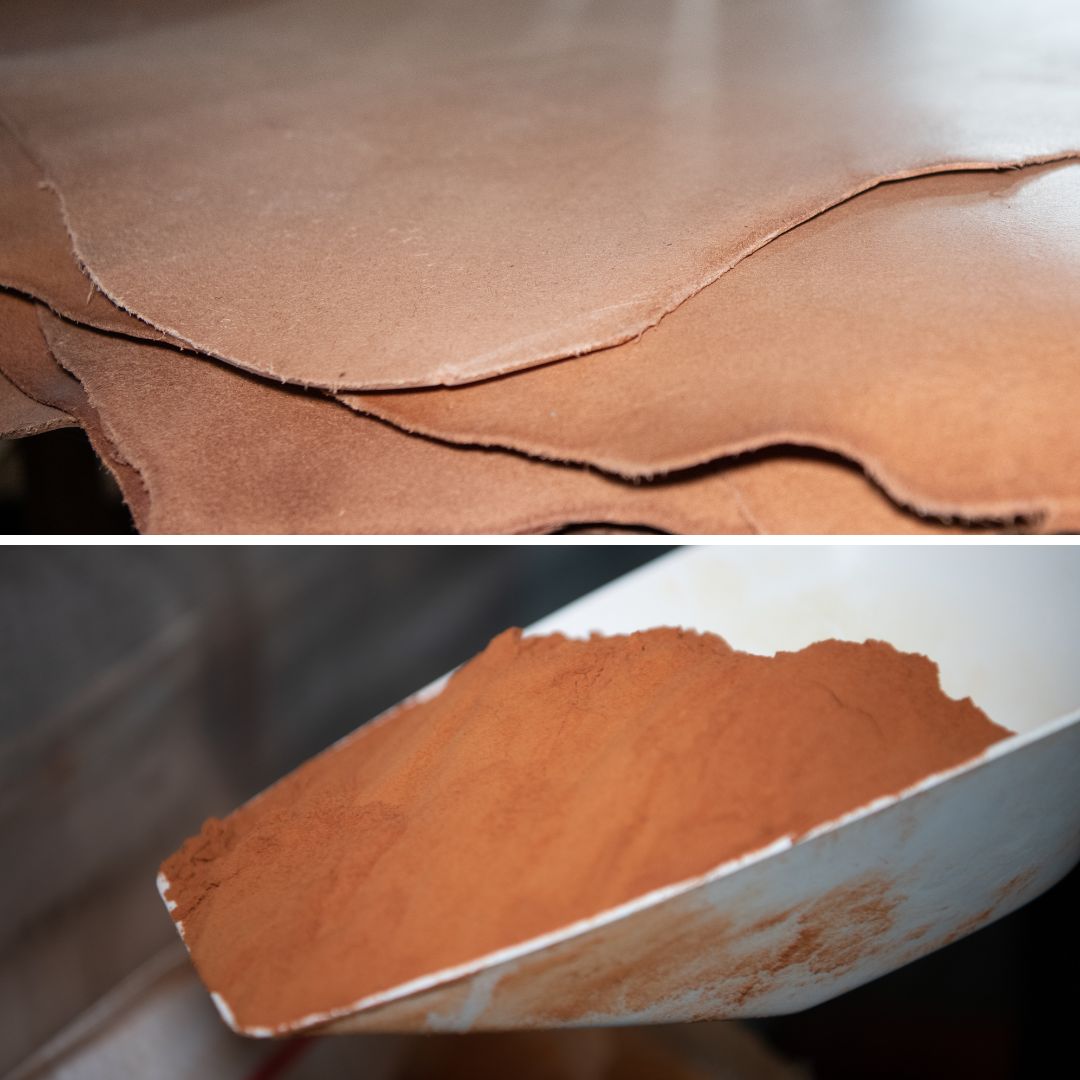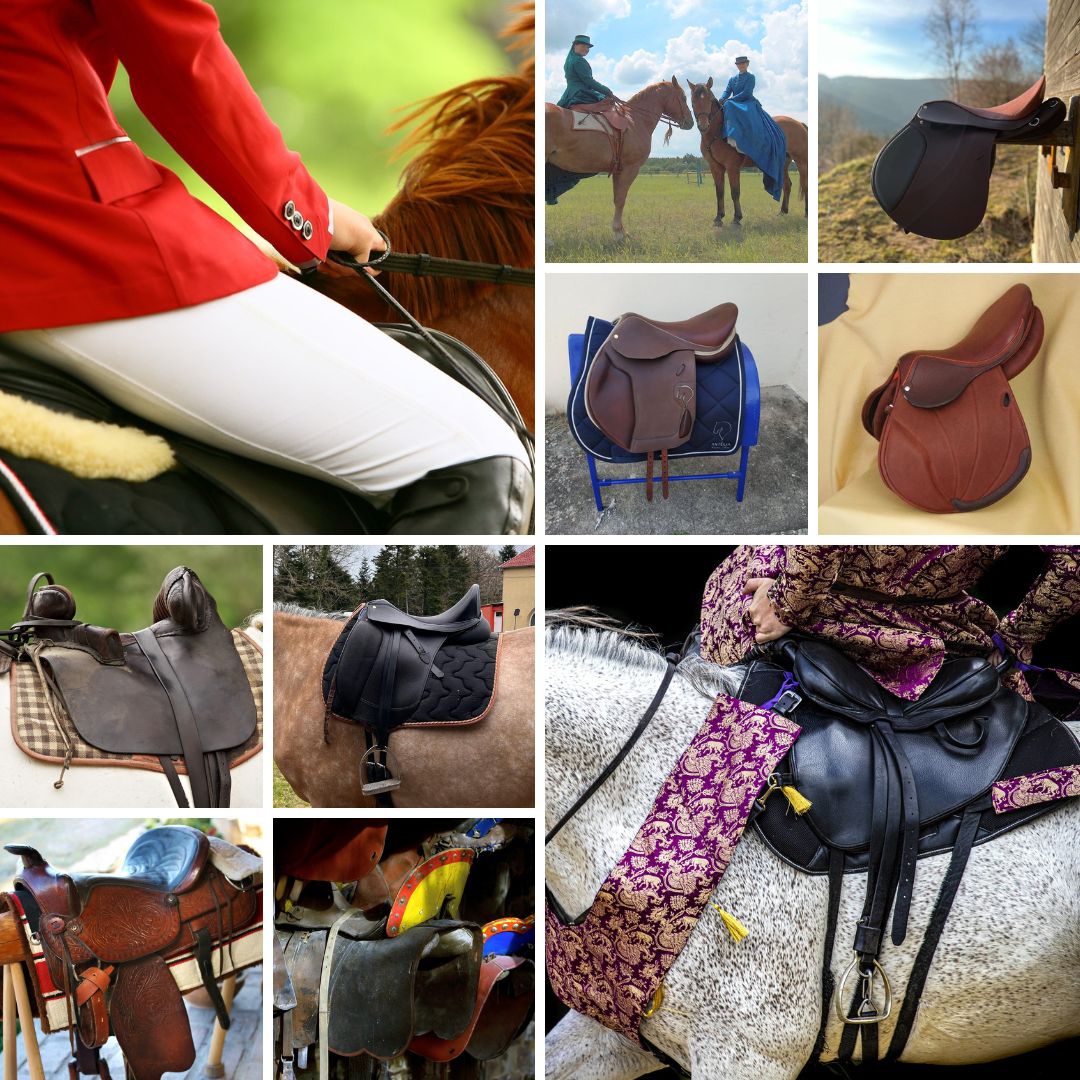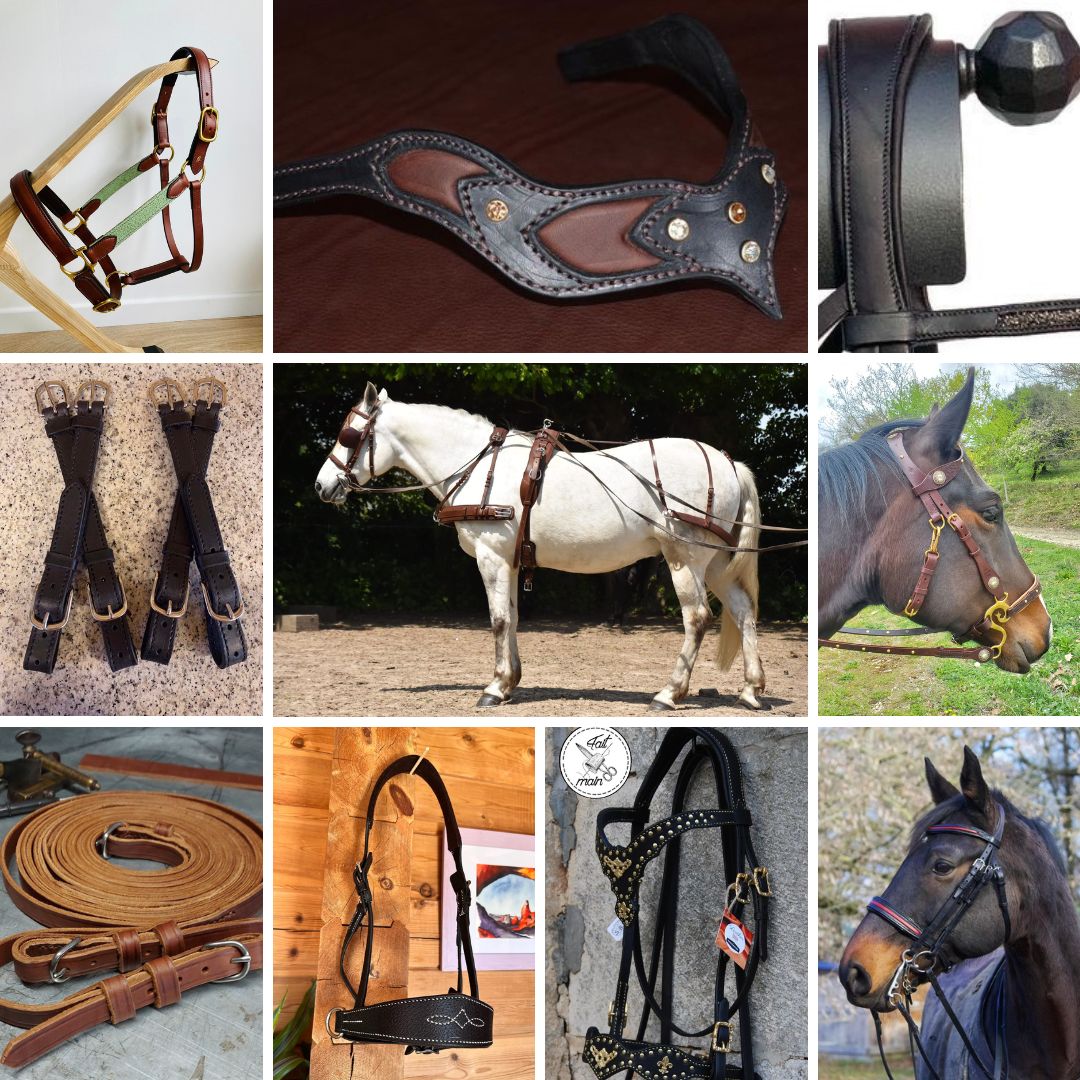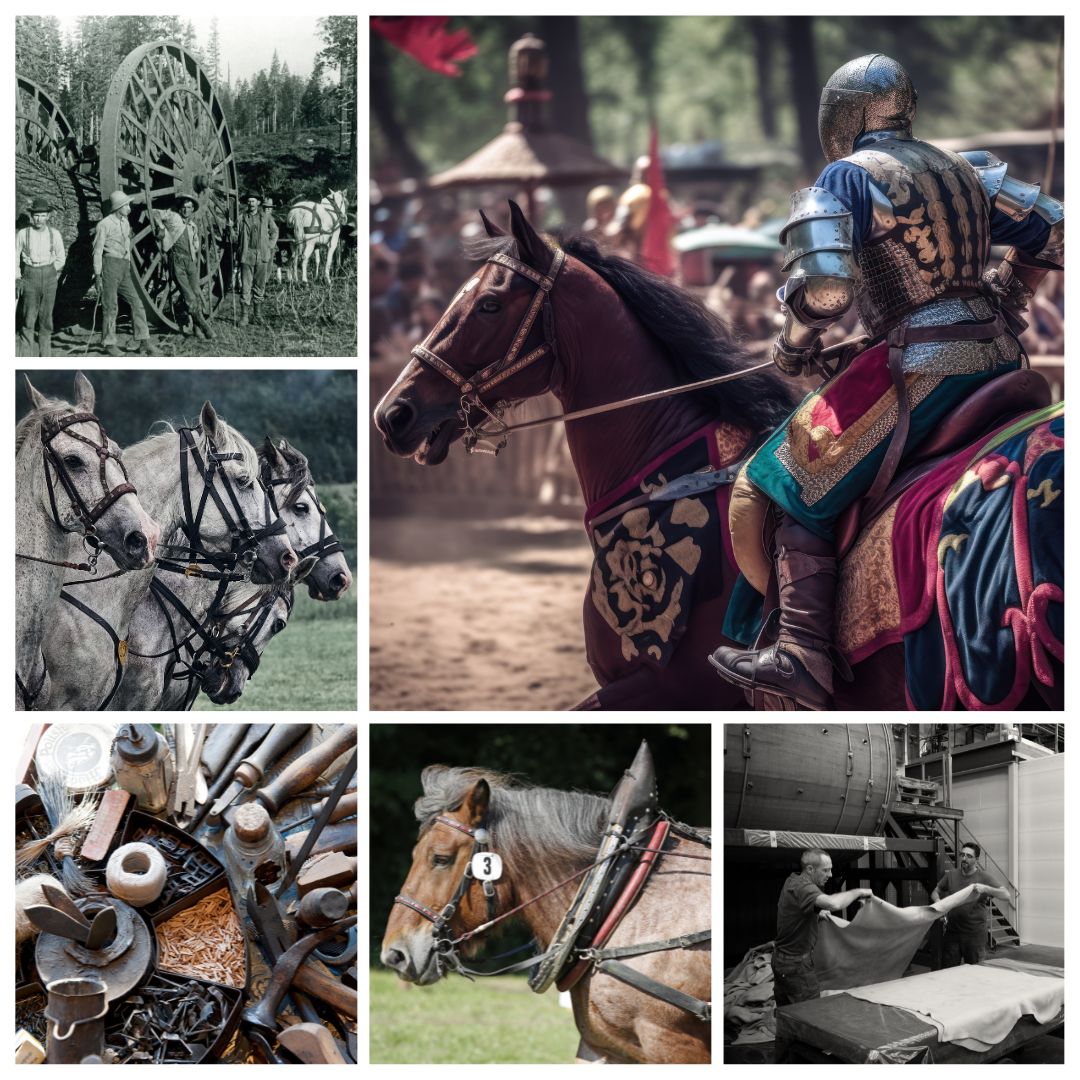
Leather in prehistory

In prehistoric times, the use of leather dates back several thousand years. Early humans quickly realized that the skins of the animals they hunted could provide protection against the elements and predators. Here are a few facts about the use of leather in prehistoric times:
- Protection and clothing: Prehistoric peoples used animal skins to cover themselves and protect themselves from harsh weather conditions. They made rudimentary garments by sewing and assembling hides using tendons, ligaments or plant fibers. These leather garments kept them warm during the cold seasons, and protected them from scratches and wounds.
- Shelters and tents: Animal skins were also used to make temporary shelters. Prehistoric hunter-gatherers stretched hides over wooden frames or bone structures to create tents or shelters. These leather shelters offered additional protection against wind, rain and other elements.
- Handicrafts and tools: Prehistoric peoples also used leather to make a variety of tools and handicrafts. They cut pieces of hide to make ropes, thongs and straps to tie up or carry objects. They also used pieces of leather to make bags, cases, belts and other items essential to their daily lives.
Although formal tanning techniques had not yet been developed, prehistoric peoples discovered rudimentary methods for preserving hides. They removed the flesh and hair from animal skins and treated them with natural substances such as salt, animal fat or brain to soften them and prevent them from decomposing.
It's important to note that precise knowledge of leather use in prehistoric times is limited, as organic materials degrade rapidly over time. The information we do have is mainly based on archaeological finds such as bone or stone tools used to work leather, artistic representations or traces of stitching on ancient hides.
Leather and ancient civilizations

Ancient Egyptian, Greek and Roman civilizations already recognized the value of leather.
In the days of ancient civilizations such as Egypt, Greece and Rome, leather was a precious material used in a wide variety of fields. Here are just a few of the ways in which leather was used in those days:- Clothing and accessories: Leather was used to make clothing and accessories. The Egyptians wore leather sandals and used leather belts to hold their clothes in place. The Greeks and Romans also used leather sandals, socks and belts. The rich and elite could wear richly decorated leather garments.
- Armor and military equipment: Leather was used to make pieces of armor and military equipment. In ancient Greece, hoplites wore leather armor to protect themselves in battle. The Romans also used reinforced leather cuirasses, helmets and shields for their soldiers. Leather was prized for its flexibility and ability to absorb impact.
-
 Travel accessories: Leather was used to make travel bags, luggage and cases. Travelers of the time carried their belongings in sturdy, durable leather bags. The Romans used leather bags called "Pera" or "Loculus" to carry their belongings on the move.
Travel accessories: Leather was used to make travel bags, luggage and cases. Travelers of the time carried their belongings in sturdy, durable leather bags. The Romans used leather bags called "Pera" or "Loculus" to carry their belongings on the move. - Furniture and furnishings: Leather was used to cover furniture, seats and cushions. Wealthy Roman homeowners had wooden furniture luxuriously upholstered in finely worked leather. Leather was also used to create carpets and wall hangings.
- Manuscripts and book bindings: Leather was used to make parchment and book bindings. Ancient manuscripts were generally written on parchment, which was animal skin specially prepared for writing. Book bindings were often made of leather, sometimes richly decorated with motifs and ornaments.
Tanning techniques at the time varied. Vegetable vegetable tanningusing plant extracts to treat the hides, were common. Tanners also used substances such as salt and vinegar to preserve hides and make them more durable.
The use of leather in ancient civilizations testifies to its importance as a versatile material, offering protection, comfort and aesthetics to different facets of daily life and the culture of the time.
Leather in the Middle Ages

The Middle Ages were an important period for the leather industry. Tanners became craftsmen specialized in hide processing. They developed tanning techniques that transformed raw hides into supple, hard-wearing leather.
In the Middle Ages, leather played an essential role in many aspects of daily life. It was used to make clothes, armor, shoes, leather goods and much more. Here's an overview of how leather was used in the Middle Ages:
- Clothing and footwear: Leather was a common material for clothing. Peasants and workers wore leather tunics and jackets to protect themselves from the elements. Wealthy nobles and knights could afford finely crafted leather garments, such as capes, cloaks and vests. Leather footwear was also widespread, from simple sandals to more elaborate boots.

- Armor and military equipment: Leather was used in the manufacture of light armor. Leather breastplates, often reinforced with metal plates, were worn by archers, crossbowmen and other lightly armed soldiers. Leather armor pieces, such as armbands, leggings and gauntlets, offered additional protection to combatants.
- Leather goods: Tanners and leather craftsmen produced a variety of leather goods. Bags, purses, knife cases, belts and bracelets were all made from leather. Craftsmen used embossing and cutting techniques to create decorative patterns and ornaments on these items.
- Book bindings: In the Middle Ages, leather was widely used for book bindings. Precious manuscripts were often covered in finely worked leather, sometimes richly decorated with patterns and gilding. Specialized tanners and bookbinders used advanced techniques to produce strong, aesthetically appealing bindings.
- Saddlery: Saddlery was another area where leather was used. Saddles, harnesses and reins were made from leather, offering the strength and durability needed for working with horses. Saddlers also used embossing and sewing techniques to add decorative details.
In addition to these uses, leather was also used in other areas such as the manufacture of purses, gloves, shields and even tents. Tanning techniques were often based on artisanal methods and required specialized skills. Leather was treated with substances such as oak bark to make it supple, strong and suitable for a variety of applications.
In short, leather was a versatile and indispensable material in the Middle Ages, used in the manufacture of clothing, armor, leather goods and other items necessary to the daily life and economic activity of the time.
Leather in the Renaissance and modern period
During the Renaissance, leather was a prized material for luxury garments. Nobles and wealthy bourgeois wore richly decorated leather garments. Over time, leather became a common material for shoes, gloves, bags and other fashion items.
During the Renaissance and modern eras, leather continued to be widely used in many areas, both in fashion and in other industries. Here's an overview of how leather was used during this period:
- Fashion and clothing: Leather was highly valued in Renaissance fashion. Nobles and wealthy burghers wore elaborate leather garments, such as jackets, pourpoints and cloaks, often decorated with embroidery, metallic ornaments and intricate patterns. Leather accessories, such as gloves and belts, were also popular.
- Shoes and boots: Leather shoes and boots were commonly worn by Renaissance men and women. Richly decorated leather shoes were considered a sign of high social status. Leather boots were often used by horsemen and soldiers, offering enhanced protection and durability.
- Luxury leather goods: The craft of leather goods developed during the Renaissance, with the creation of luxury leather goods. Finely crafted leather handbags, purses, card holders and jewelry boxes were made for the wealthy classes. These pieces were often decorated with intricate patterns and inlays of precious metals.
- Bookbinding and stationery: Leather has always been used for bookbinding, but binding techniques have evolved. The bookbinders of this
The craftsmen of the time developed more sophisticated methods, using gilding patterns, carved ornaments and inlays to create sumptuous bindings. Leather was also used to make document boxes, pencil boxes and other stationery.

- Interior fittings: Leather was used in interior fittings, in particular to cover seats and furniture. Chairs, armchairs and sofas were upholstered in quality leather, offering both comfort and aesthetic appeal. Walls were sometimes upholstered in decorative leather, known as Cordoba leather, which was often embossed with intricate patterns.
-
Equestrian accessories: Leather was used to make equestrian accessories such as saddles, bridles, stirrups and halters. Renaissance horsemen used high-quality, often richly decorated leather goods for their horses. These items were both functional and aesthetically pleasing.
The use of leather at this time reflected a taste for luxurious materials and sophisticated decoration. Tanners and leather craftsmen continued to perfect tanning techniques and develop more complex decoration methods to meet the growing demand for quality leather products.
It's important to note that leather was also used in other fields, such as the manufacture of weapons, travel objects (like trunks and cases), and in the maritime industry for shipbuilding. Leather played an important role in the daily life and crafts of the period.
Leather and the Industrial Revolution

With the advent of the Industrial Revolution in the 18th century, leather production underwent a significant transformation. Machines were introduced to speed up the tanning process and make leather production more efficient. This made it possible to meet the growing demand for leather as the population grew and industrialization progressed.
Here's how leather was impacted during this period:
- Mass production: The industrial revolution introduced mass production methods, which greatly increased leather output. Machines were developed to facilitate the tanning and working of leather, speeding up the manufacturing process. Large factories replaced small artisan tanneries, enabling production on a much larger scale.
- Innovation in tanning: During this period, new tanning techniques were developed. The use of chemicals, such as chromium salts, became commonplace, considerably reducing the tanning time required.
- Industrial applications: Leather has been used in many booming industrial sectors. For example, leather was used in the textile industry for machine belts, threads and bearings. It was also used in the mining industry for safety belts and impact-resistant boots. Radermecker Tannery produces belts, friction bandages and other leather goods for industry.
- Leather goods: Industrial production led to increased availability of leather goods such as bags, wallets, purses and card holders. These leather goods were increasingly accessible to the general public.
- Footwear and clothing: The use of leather in the manufacture of shoes and clothing has also undergone significant changes. Mass production techniques have made it possible to manufacture a wide variety of leather shoes at affordable prices. Leather garments, such as jackets and coats, have also become more affordable thanks to efficient production methods.
Despite these changes, the traditional use of leather in clothing, accessories and furnishings remained widespread. Leather continued to be appreciated for its durability, aesthetic appeal and resistance.
The Industrial Revolution thus transformed the leather industry, introducing advanced production methods and enabling increased availability of leather products. These developments contributed to a more widespread use of leather in various industries, and increased accessibility for a wider range of people.
Leather in the modern age
Today, leather is used in a wide variety of fields. It is used to make clothes, shoes, bags, furniture and decorative items. The fashion and luxury goods industry continues to play a major role in the use of leather, although synthetic alternatives have also gained in popularity due to ethical and environmental concerns.
In the modern era, leather continues to be a popular and appreciated material in many fields. Here's how leather is used today:
- Fashion and accessories: Leather remains a preferred choice in the fashion industry. Leather garments, such as jackets, pants and skirts, are always in fashion. Leather accessories, such as handbags, wallets, belts and shoes, remain in high demand. Leather offers a combination of durability, comfort and aesthetics that makes it attractive to many people.
- Leather goods: The craft of leather goods has developed and diversified. Leatherworkers create high-quality leather products, such as luxury handbags, wallets, card holders, key rings and many other items. Leather processing techniques have also evolved, enabling sophisticated finishes and intricate patterns.
- Furniture and furnishings: Leather is used to cover furniture, sofas, armchairs and chairs. Leather furniture items are appreciated for their elegant appearance, durability and comfort. Different types of leather are used, such as full grain leatheraniline leather and reconstituted leather.
- Automotive: Leather is widely used in the automotive industry for car interiors. Leather seats, steering wheels and interior trim add a touch of luxury and sophistication to vehicles. Leather is appreciated for its resistance to wear and tear and its high-end aesthetic appeal.
- Travel goods: Leather bags and luggage are always popular for travel. Leather suitcases, travel bags and briefcases are known for their sturdiness and timeless style. Leather offers protection for items carried and improves over time, developing a unique patina.
- Sport and leisure: Leather is used in the manufacture of certain sports equipment, such as footballs, baseball gloves and riding saddles. Leather is prized for its strength and ability to withstand rigorous conditions.
Leather remains a versatile and popular material in the modern age, used in a wide variety of applications from fashion to furnishings, accessories and equipment.
From its primitive use by our ancestors to its central place in modern society, leather has adapted and evolved through the ages. This fascinating history reminds us of the importance and versatility of this unique material. While new alternatives are emerging, leather retains its timeless appeal and continues to play a major role in our daily lives.

